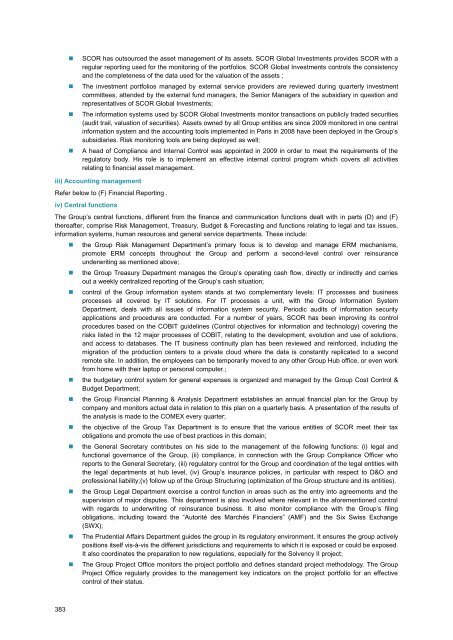4.4 Legal risk - Scor
4.4 Legal risk - Scor
4.4 Legal risk - Scor
Create successful ePaper yourself
Turn your PDF publications into a flip-book with our unique Google optimized e-Paper software.
• SCOR has outsourced the asset management of its assets. SCOR Global Investments provides SCOR with a<br />
regular reporting used for the monitoring of the portfolios. SCOR Global Investments controls the consistency<br />
and the completeness of the data used for the valuation of the assets ;<br />
• The investment portfolios managed by external service providers are reviewed during quarterly investment<br />
committees, attended by the external fund managers, the Senior Managers of the subsidiary in question and<br />
representatives of SCOR Global Investments;<br />
• The information systems used by SCOR Global Investments monitor transactions on publicly traded securities<br />
(audit trail, valuation of securities). Assets owned by all Group entities are since 2009 monitored in one central<br />
information system and the accounting tools implemented in Paris in 2008 have been deployed in the Group’s<br />
subsidiaries. Risk monitoring tools are being deployed as well;<br />
• A head of Compliance and Internal Control was appointed in 2009 in order to meet the requirements of the<br />
regulatory body. His role is to implement an effective internal control program which covers all activities<br />
relating to financial asset management.<br />
iii) Accounting management<br />
Refer below to (F) Financial Reporting .<br />
iv) Central functions<br />
The Group’s central functions, different from the finance and communication functions dealt with in parts (D) and (F)<br />
thereafter, comprise Risk Management, Treasury, Budget & Forecasting and functions relating to legal and tax issues,<br />
information systems, human resources and general service departments. These include:<br />
• the Group Risk Management Department’s primary focus is to develop and manage ERM mechanisms,<br />
promote ERM concepts throughout the Group and perform a second-level control over reinsurance<br />
underwriting as mentioned above;<br />
• the Group Treasury Department manages the Group’s operating cash flow, directly or indirectly and carries<br />
out a weekly centralized reporting of the Group’s cash situation;<br />
• control of the Group information system stands at two complementary levels: IT processes and business<br />
processes all covered by IT solutions. For IT processes a unit, with the Group Information System<br />
Department, deals with all issues of information system security. Periodic audits of information security<br />
applications and procedures are conducted. For a number of years, SCOR has been improving its control<br />
procedures based on the COBIT guidelines (Control objectives for information and technology) covering the<br />
<strong>risk</strong>s listed in the 12 major processes of COBIT, relating to the development, evolution and use of solutions,<br />
and access to databases. The IT business continuity plan has been reviewed and reinforced, including the<br />
migration of the production centers to a private cloud where the data is constantly replicated to a second<br />
remote site. In addition, the employees can be temporarily moved to any other Group Hub office, or even work<br />
from home with their laptop or personal computer.;<br />
• the budgetary control system for general expenses is organized and managed by the Group Cost Control &<br />
Budget Department;<br />
• the Group Financial Planning & Analysis Department establishes an annual financial plan for the Group by<br />
company and monitors actual data in relation to this plan on a quarterly basis. A presentation of the results of<br />
the analysis is made to the COMEX every quarter;<br />
• the objective of the Group Tax Department is to ensure that the various entities of SCOR meet their tax<br />
obligations and promote the use of best practices in this domain;<br />
• the General Secretary contributes on his side to the management of the following functions: (i) legal and<br />
functional governance of the Group, (ii) compliance, in connection with the Group Compliance Officer who<br />
reports to the General Secretary, (iii) regulatory control for the Group and coordination of the legal entities with<br />
the legal departments at hub level, (iv) Group’s insurance policies, in particular with respect to D&O and<br />
professional liability;(v) follow up of the Group Structuring (optimization of the Group structure and its entities).<br />
• the Group <strong>Legal</strong> Department exercise a control function in areas such as the entry into agreements and the<br />
supervision of major disputes. This department is also involved where relevant in the aforementioned control<br />
with regards to underwriting of reinsurance business. It also monitor compliance with the Group’s filing<br />
obligations, including toward the “Autorité des Marchés Financiers” (AMF) and the Six Swiss Exchange<br />
(SWX);<br />
• The Prudential Affairs Department guides the group in its regulatory environment. It ensures the group actively<br />
positions itself vis-à-vis the different jurisdictions and requirements to which it is exposed or could be exposed.<br />
It also coordinates the preparation to new regulations, especially for the Solvency II project;<br />
• The Group Project Office monitors the project portfolio and defines standard project methodology. The Group<br />
Project Office regularly provides to the management key indicators on the project portfolio for an effective<br />
control of their status.<br />
383
















